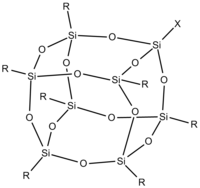
Photo from wikipedia
The Fischer–Tropsch synthesis to lower olefins (FTO) is a desirable nonpetroleum‐based route to produce basic chemicals. A novel two‐step method was applied to synthesize iron‐based supported catalysts, which is to… Click to show full abstract
The Fischer–Tropsch synthesis to lower olefins (FTO) is a desirable nonpetroleum‐based route to produce basic chemicals. A novel two‐step method was applied to synthesize iron‐based supported catalysts, which is to prepare nano‐Fe3O4 first by thermal decomposition method and sequentially load them on α‐Al2O3 by impregnation. TEM and XRD results manifested that the controllable, uniform Fe3O4 nanoparticles are monodispersed on the surface of α‐Al2O3. H2‐TPR demonstrated that the reduction of Fe species was facilitated because of the weak interaction between Fe species and the support. These superior properties contribute to an enhanced catalytic activity and stability compared with the catalyst prepared by directly impregnating ammonium iron citrate on α‐Al2O3. Then, the effect of promoters was investigated at the same Fe loading and nanoparticle size. The appropriate addition of K could enhance the catalytic activity and suppress the secondary hydrogenation. On the contrary, S has a negative impact on CO conversion and strongly decreases C5+ selectivity. Particularly, the combination of K and S could obtain more pronounced CO conversion and higher lower olefins selectivity (≈40 %). Furthermore, size effects were explored by precisely tailoring the iron oxide particle size with the Fe loading kept constant. It was found that 12.0 nm nano‐Fe3O4 on α‐Al2O3 with or without K plus S promoters showed the best catalytic activity among the catalysts with different particle size.
Journal Title: ChemCatChem
Year Published: 2017
Link to full text (if available)
Share on Social Media: Sign Up to like & get
recommendations!